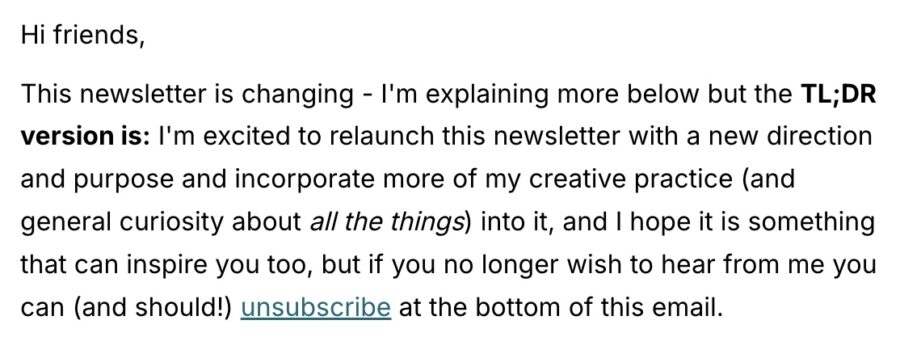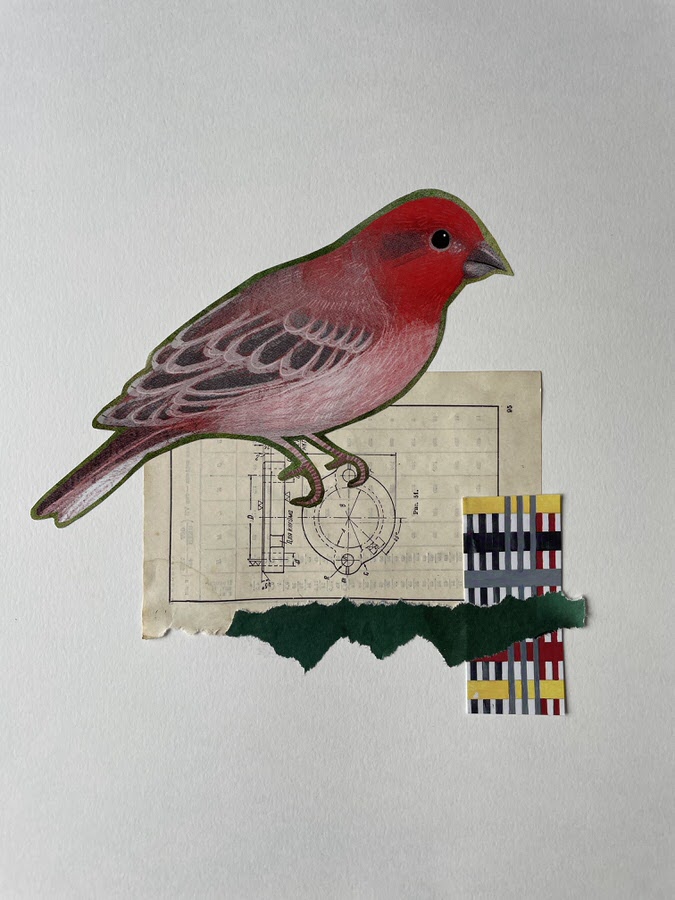I have written recently about my decision to leave Substack, resurrect my own blog and get back to managing my own newsletter. Today, I’ll go over the choices I made (and why I made them) because I know how useful it can be for others considering similar moves.
But first, let me lift the curtain a little bit and show you when my set up looked like until now.
My previous (very messy) set up
So here’s the thing. I probably would not have done the switch (yet) had it not been for MailerLite, my mailing list provider, doing a fairly sudden switcheroo on me (and thousands of others) and deciding that actually, a free account only gets you 500 subscribers, not 1000 as previously advertised.
“MailerLite? I thought this was about Substack” I hear you scratching your head in befuddlement.
Well, yes, exactly.
See, as it stood until recently my set up was pretty convoluted. That comes from doing this thing for over 15 years, trying a bunch of different stuff and bootstrapping it through all ups and downs as standard practice.
I’ve had a newsletter in some shape or form since 2009 or so, when I started my photography business. I had a newsletter when MailChimp was still an hippie underdog and was giving out free t-shirts to help promote their brand (I used to have one, it was really cool).
I always knew – and preached – that owing a contact list (and your own web space – as opposed to a social media profile) was more valuable in the long run, even at the time when many fellow photographers built their whole huge businesses off just a Facebook page – and then have seen it all collapse as Meta’s (before it was Meta) priorities changed.
Over time my simple email list got segmented into people interested in my photography services, and photographers I was mentoring as I started expanding the educational side of my business. But I always struggled to “segment” myself and send different things to different people to “stay top of mind” so to speak (for more on that, see my essay about personal branding and the fracturing of self).
Newsletters and drip sequences started and stopped with varying degrees of success and consistency, but nothing felt quite right until I started Work in Progress newsletter on Substack at the end of 2022. I did it with the intention of getting back to writing what I wanted to write, and write for artists and creatives like me, rather than trying to craft regular marketing messages on topics I was no longer really interested in talking about (I mean how many variations on “how to photograph your kids” and “best places for a family photoshoot in London” can one reasonably write over the span of 15 years and not go insane get bored out of their damn mind?!).
I tried to balance these two for a while: an occasional newsletter to my past and potential photography clients with brief updates on my availability, and a more frequent and free-flowing Substack, but ultimately it became more convoluted than helpful, and I knew I had to bring it all together, but I couldn’t quite figure out how to make it work – and keep everyone happy.
Until I realised I can’t keep everyone happy. I need to keep me happy and creative and the rest will follow. Not everyone will want to continue with me on this journey and it’s totally okay (jumping ahead: a few dozen people did unsubscribe pretty instantly, some of which did surprise me, and I’m sure more will follow as I work things out, but I’m really not taking it personally – or at least trying to, rejection sensitivity is strong in this one but it’s definitely something I’ve learned to deal with better over the years).
Still, I had no actual, practical solution to my newsletter problem…
And then MailerLite switcherooed, and with a fairly short notice. The irony is, I would have upgraded to a paid account once I hit 1,000 subscribers – I wasn’t that far off (and yes, it’s not a huge number, but I wasn’t actively promoting my newsletter for the past 5+ years, which is so dumb but it is what it is… and also I’d rather have 1,000 engaged subscribers than 10,000 people that never open my emails at all). Still, I don’t like to be forced into something before I’m ready so I was up against a deadline to find a new solution.
And don’t we auDHDers LOVE a deadline to get shit done and find all the solutions to previously – seemingly – unsurmountable problems?

Email marketing newsletter options
I looked at SO MANY options it honestly made my head spin and analysis paralysis nearly struck. But, I had a deadline (and also my website built-in newsletter sign up form decided to break so the extra pressure was on to just fix the whole thing in one swoop).
Here’s what I considered (I will not be detailing all the pricing as it’ll probably change over time – you can look it up yourself). I’m focusing on free options here because (a) that was my personal priority (see: “bootstrapping” above) and (b) I know for many other artists and creators it would be the most helpful thing right now. I should also say I’ve been looking at all the options with the view that in a year or so I would probably need to start paying, whether because my list would have grown, or I needed more functionality than a free account allowed.
MailerLite
I mean it is a pretty good deal with pretty reasonable pricing and a lot of really good features (like unlimited forms and automations) and I was seriously considering just staying, even though I was extremely salty about their moves, but I had a few years experience with MailerLite and its interface is not the best in my opinion, so ultimately, I decided against it.
Buttondown
Buttondown came up a lot with the artists and creators I recently started following. It was also the cheapest of the bunch (90 USD per year up to 1,000 subscribers, and 290 USD up to 5,000) and had paid newsletter functionality, newsletter archive page, and is run by a small team of developers. What’s more their help pages detail why you would choose other providers over them (love that kind of marketing confidence) and I seriously considered it, because I really wanted to support a small indie business – but ultimately I just didn’t vibe with the interface and the lack of design customisation options.
Beehiiv
Beehiiv was another option that came up as I followed down some rabbit holes and it was free for up to 2,500 subscribers (if you didn’t want automations or any of the actually useful features) but it had more of a Substack vibe to it but with an added HUGE focus on ad revenue, so it was a pass for me, personally.
Ghost
Ghost also came up a lot as an ethical (and potentially open source) alternative to Substack but unless you know your way around databases and PHPs (I’m fairly technically savvy but the whole thing made me want to run in the opposite direction), you have to get their managed GhostPro option which I thought was pricey, in comparison.
MailChimp
I even considered my old provider, MailChimp, but it felt too expensive all considering, and who wants to go backwards, anyway (after all, I left MailChimp for MailerLite when they pulled a similar switcheroo and effectively got rid of more of less functional free accounts they built their whole brand on previously, supporting the little (wo)man and so on – yeah, right).
Other options that came up were Email Octopus and SendFox (one-time fee option) but if I’m honest by then I’d already made up my mind so I didn’t explore them in any great detail.
Kit
I finally landed on Kit. It was recommended to me by a few people before, but I always assumed they don’t have a very functional free option (or so the website makes it look). Upon further inspection, however, it appeared that the free option is pretty functional if you are willing to keep it simple. You get up to 10,000 subscribers (yes, TEN THOUSAND) but the pay off is you only get one form and one automation, and have to display the Kit logo on all your emails and forms (you can hide the forms logo with a simple line of CSS code though). Basically, they allow you to grow your list unhindered, and you can choose when you’ve outgrown the limitations and upgrade in your own time, which I like.
Still, the limitations on the number of automations was significant (I’m used to being able to set up sequences for various things I might dream up) and it’s not the cheapest of the bunch, at 390 USD per year for up to 1,000 subscribers (and a eye-watering 890 USD for up to 5,000 – comparing to, say, Buttondown’s 290 USD) but I decided that it would probably be worth it by the time I decide to upgrade (my goal is to get to 5,000 subscribers by the end of next year – a lofty one, considering I’m at 1,000 fifteen years in, lol, but let’s aim high – so do spread the word!) and the plan was to keep things simple for the time being, with just a newsletter and nothing too clever for the time being.
Kit’s newsletter writing interface is also very nice and the closest to Substack which I enjoyed so much: lots of white space, nice fonts – and my favourite that none of the others seemed to have, you can have highlighted text (as in, a different colour background, as if you used a marker)! It’s such a small design thing but for a visual person like me things like these make all the difference.
So, I was all set. Decision made, email lists exported and transferred (both Substack and MailerLite have easy export options although you do lose people’s history of interacting with your newsletter in the process), forms designed and set up in all the right places.
Right?
Right?!?!?!?
Well, wrong.
After all that work, I sat with that decision for a little longer and realised that if my goal was indeed to grow my list, I would be foolish for me to commit to paying twice as much for Kit’s features, compared to perfectly serviceable MailerLite which worked out at about half the price.
I swallowed my annoyance and upgraded.
Sometimes you have to follow the wrong path first to get where you need to be going.
My new set up (as of October 2025)
My blog is on self-hosted WordPress and I use Divi as my website theme (I have a lifetime Divi subscription from a while back so despite my occasional attempts to find a good alternative I opted to stay put and currently use Divi 5 public alpha as it no longer uses the dreaded shortcodes… but that’s a potentially very boring side quest we are just not going to explore today).
To make the transition to a unified mailing list I downloaded all my Substack subscribers as .cvs spreadsheet files and imported them into MailerLite. I may have ended with duplicates as some people have used different email addresses for different lists, but I’m already seeing them sort themselves out – we all do end up with duplicate subscriptions sometimes.
When moving lists, you want to make sure you only export active subscribers, as you should not be sending emails to people who have long unsubscribed (depending on your current provider there will be different toggles for you to get to that list; I believe Substack only gives you the list of active subscribers anyway). However I would also recommend downloading all the unsubscribed and bounced email addresses from your current provider too, if you have that option – just so that you have the record of them. I made sure to add appropriate tags on import so I could identify where those emails originally came from, and simplified my overall backend so it’s just one big newsletter list rather than various groups that have long become redundant (it is also easier for my brain not to second-guess who should receive what, which is partly the reason for this whole big transition!).
I should also note that I didn’t have very many paid subscribers on Substack, and decided to no longer have a paid newsletter (for the time being anyway), so I didn’t have to deal with transferring recurring payments, so I can’t advice on that.
Prior to all of that I manually transferred of of my posts from Substack (that took a couple of days!) and built my sign up form and embedded it on my website.
I’ve let my Substack subscribers know I’m switching over and I’ve sent my MailerLite subscribers a welcome email introducing Chaos Theory, explaining what it was and inviting them to unsubscribe right at the top of the email, if they didn’t want to continue receiving these emails from me.

A number of people did unsubscribe which is great for my overall newsletter health list, even if it stings a little, sometimes.
For now I’m keeping things simple and there isn’t really any kind of automation behind it like there was on Substack: I write the newsletter and I send it out in with MailerLite. It doesn’t automatically populate my blog – I do it manually and I can always decide which ones get published and which ones stay newsletter-only (not everything needs to be an official essay on the blog, really).
Marketing-wise (because yes, I’m doing it for me but also it is a business and I do need to make money, because capitalism, duh) my goal is to grow my newsletter pretty significantly (as mentioned above, I want to get to 5,000 subscribers by the end of 2026, so please do spread the word) by providing interesting essays on a variety of topics that all, somehow, in ways I don’t fully understand, feed into my own creative practice – and hopefully inspire and educate others, too. It also keeps keeping me accountable: I cannot create in secret or silence, I need to be sharing my work with people in order to keep myself motivated and accountable to keep going, so it really does serve a double purpose.
I hope this entry was helpful. I don’t have comments enabled so I don’t obsess over who commented and who didn’t, and also spam is a real problem I don’t want to have to deal with, but feel free to drop me an email any time, I love to chat!
Ultimately, the best thing about owning your mailing list is that you can move it around, and you can change your mind any time, picking what’s best for you. Don’t be afraid to experiment if you feel like you need to.


